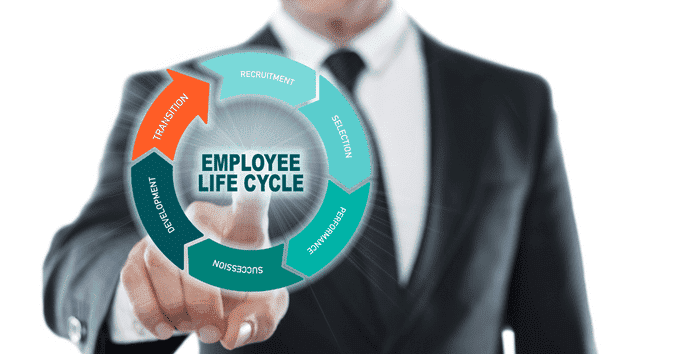6 Stages of the Employee Life Cycle: Strategies for Success at Each Stage

You’ve probably heard the term “employee life cycle” before, but what exactly is it?
The employee life cycle is a pivotal aspect of any HR department. It’s the path that employees take as they interact with your company. To experience sustained success as an employer, you need to understand each stage of the lifecycle and act accordingly.
As a person who’s experienced a wide array of workplaces, I can tell you first-hand that the way a company handles the employee life cycle makes a huge difference in the quality of the workplace.
Read on to learn more about each stage and the correct strategy for it.
What is the employee life cycle?
The employee life cycle is the series of stages that every employee goes through on their journey and relationshipOpens in a new tab with you as an employer.
There are six stages to the employee life cycle, through which an employee goes in chronological order.
Employee life cycle model
There are several models for the employee life cycle, and each one of them has slight differences in the stages they include.
However, what they all have in common is that they start with the exposure of a prospective employee to the company and end when the employee leaves the company.
Mapping the employee life cycle
In the most successful companies, the HR team not only engages in employee life cycle management, but also maps and measures it.
Employee journey mapping includes tracking the rate of employee turnover, rate of promotions, productivity, and training costs per employee.
What are the stages of the employee life cycle model?
The six stages of the employee lifecycle are:
- Attraction
- Recruitment
- Onboarding
- Retention
- Development
- Separation
Why is it important to design a life cycle strategy?
You may be wondering, what is employee experience and why does the employee life cycle actually matter?
Understanding the employee life cycle and designing a strategy for each stage is a great way to keep your employees happy and motivated. It gives you a clearer idea of employees’ experience with your company from the day they first heard of it, up to the day they leave.
By ensuring that this experience is a positive one, you can build a solid reputation as a desirable workplace. Ultimately, this reduces employee turnover and the costs that come with itOpens in a new tab.

6 stages of the employee life cycle
Let’s take a deeper dive into each phase of the employee life cycle in terms of what it involves. We’ll also discuss how to improve employee experience at each stage using different optimization strategies and metrics.
1. Attraction
You may be under the impression that the employee's journey starts when a new employee first sets foot in the office. However, this isn’t the case. The first step of the employee lifecycle model occurs before a prospective employee even applies for a position at your company.
The attraction stage refers to the initial exposure of an employee to your image as a company.
This is when the employee starts gathering more information about your company culture and familiarizes themselves with it. More specifically, they seek more information about the structures, valuesOpens in a new tab, and the general way in which things are done within your organization.
The attraction stage is a critical component of the employee lifecycle. This is because it’s the deciding factor as to whether an employee will proceed to apply for a position at your company or not. Executing this stage correctly will also help you attract and retain top talent.
Suitable strategies
The key to having success in drawing potential employees in during the attraction stage is to develop your brand. This starts with establishing a company culture that’s a desirable work environment for prospective applicants.
Generally speaking, people are more likely to want to be a part of a culture that fosters their development as professionals. They’ll also be more likely to want to work at a place that gives them the space to take risks and innovate.
You should note that any information you put out there will be taken with a grain of salt. This is because potential employees know that it’s your company promoting its own culture, so they’ll be wary that there’s a degree of bias involved.
A great way to counteract this issue is to prominently display testimonials from your former and existing employees about how positive your work environment is.
KPIs and tools
A good tool to use at this stage is one that tracks your current employees’ attitudes toward your company’s culture. This is because their outlook is likely to be similar to potential candidates.

2. Recruitment
This is the stage in which a prospective employee transforms into an applicant for a position at your company, and then into a current employee.
The main consideration of the recruitment process is to post an appealing job listing on your website as well as other job search platforms. This listing should highlight the details of the position and a macro-view of your organization’s mission, culture, and image.
Suitable strategies
The appeal of your job listings will depend heavily on the employee value proposition (EVP)Opens in a new tab they put forth. This communicates to potential applicants why they should want to work at your company.
Your EVP should include information on the potential for employee growth and career development at your company. It should also communicate your company’s culture and how management interacts with employees.
Finally, your EVP should include the rewards that an employee would get for working at your company. This should cover the salary, benefits, and perks they would receive.
Another thing that’s highly advised during the recruitment stage is to give your existing employees a degree of input in the process.
After all, they’re the ones that’ll be working with the new hires. Therefore, giving them a say in the matter can go a long way in making the process smoother.
KPIs and tools
During the recruitment stage, you’ll want to get a better feel of how potential recruits are responding to your job listings.
You can do so by calculating certain KPIs and comparing them to industry benchmarks. These KPIs include offer acceptance rate and time to hire.
3. Onboarding
Now that you’ve successfully attracted and recruited a new employee, the next step in the cycle is to merge them effectively into the work environment.
The onboarding stage refers to orientations and training sessions that help get your the newest members of your workforce acquainted with their surroundings. The primary goal of these orientations should allow new employees to get up to speed with the company culture and what they should expect.
More specifically, a successful onboarding stage should result in new hires being highly familiar with the organization’s values and purpose. It should also clearly define their role within the company.
Since this stage is when your new hires transition into fully productive employees, you want to minimize the time it takes. You can do this through a carefully designed, efficient training programOpens in a new tab.
Suitable strategies
One strategy that can help facilitate the onboarding process is to have a clearly defined appraisal systemOpens in a new tab. You should align new team members on how this system works so that they know exactly how their performance will be measured, and how it’ll be rewarded.
Another effective measure you can take is to assign one of your existing employees as a guide or mentor for each new hire. The one-on-one attention will make the transition easier and more comfortable. It will also allow new employees to start building relationships with their co-workers.
KPIs and tools
In order to improve and streamline your onboarding process, you’ll want to survey new hires to gauge how easy they found the process to be.

4. Retention
When an employee has been at your company for an extended period of time, they may start to feel like you don’t appreciate them and that they’re just another cog in the machine. This doesn’t mean that you have a bad culture as a place of work, in fact, this is a common occurrence in all companiesOpens in a new tab.
However, if you want to boost employee retention and minimize turnover, you’ll need to address the issue in an effective manner.
Suitable strategies
The key here is to strive to improve the employee recognition programs you have in place. That way, staff members feel like their work matters and is appreciated. This helps keep employees happy and minimizes the possibility of them opting to leave your company and get a new job.
A great way to do this is to have an employee reward and recognition program in place. The rewards can be performance-based, or they can also revolve around recognizing employees for their positive effect on the work environment. Regular employee recognition can boost employee happiness by making them feel more appreciated, respected, and connected to colleagues.
Another key aspect to consider in the retention stage of the employee life cycle is encouraging employee engagement and communication if they feel that they’re unhappy with their situation.
By giving your employees the sense that you respect them and their opinions, they’re more likely to want to work with you toward solving the issue. Otherwise, they may simply decide that they’re better off working elsewhere.
KPIs and tools
The key here is to consistently get employee feedback to gauge engagement and morale. You also need to have a better understanding of what motivates them.
5. Development
The most successful companies take this phase of the employee lifecycle very seriously. The development stage involves nurturing and growing your staff’s competencies and skill sets.
This prevents them from getting stagnant in their position and leads to them having the capacity for expanded roles.
It also gives them a sense of direction and purpose for their careers. It also allows you to attract the best talent in the field since they know that your company is a great place to work and develop their professional skills.
Suitable strategies
Developing your employees can be done either in-house, or externally.
Most companies opt to use a combination of in-house training programs and pay for external courses for their staff. Sure, this may be an added expense, but it’ll pay dividends in future productivity.
You should also give individuals that have completed professional development courses a platform to share what they’ve learned with their peers.
KPIs and tools
You can gauge how effective your employee development efforts by measuring changes in sales figures and productivity. Then, compare them to the costs incurred through training programs. If the former exceeds the latter, then you’re on the right track.

6. Separation
The last stage of the employee lifecycle occurs when they decide to part ways with your company.
Separation may happen due to retirement, seeking new employment elsewhere, or lay-offsOpens in a new tab. People may also leave for personal reasons.
Suitable strategies
The most important consideration in the separation stage is to understand why the employee is leavingOpens in a new tab. This is why an exit interview is essential. You'll be able to better understand why employee turnover occurs so you can address the issues causing it and take the necessary steps to improve the overall employee experience. This is especially important if you're experiencing high employee turnover.
You also want to make sure that the departing staff member leaves on a good note. Firstly, this minimizes the disruption experienced by your existing employees.
It also makes it more likely that the individual who’s leaving will have positive things to say about your work when people ask them.
KPIs and tools
To better understand why people are leaving, you should conduct an employee survey as part of the exit interview process. The benefit of these interviews is that they tend to provide very honest feedback.
Frequently asked questions
What is the HR lifecycle?
The HR lifecycle is just another name for the employee life cycle model.
It involves the same stages of attraction, recruitment, onboarding, retention, development, and separation.
The reason for this name is that the HR department is often heavily involved in all stages of the lifecycle.
What are the pillars of employee experience?
The five pillars of the employee experience are mental health, quality of life, growth, culture and values, and compensation and benefits.
As an employer, you should strive to maximize each of these aspects for your staff if you want them to be satisfied with their work environment and loyal to your company.
Conclusion
The employee lifecycle is the journey that an individual goes through from the moment they hear about an employer to the day they leave the company.
There are important considerations that you need to keep in mind during every stage of the life cycle. They include prospects’ first impression of your company and the extent to which they feel comfortable and appreciated once they’re part of your staff.
By doing so, you’ll effectively boost your reputation as an employer and have more loyal and productive employees.
About the author
Ryan Stoltz
Ryan is a search marketing manager and content strategist at Workhuman where he writes on the next evolution of the workplace. Outside of the workplace, he's a diehard 49ers fan, comedy junkie, and has trouble avoiding sweets on a nightly basis.